Mangalore Dispatch
![]()
Mangalore Dispatch |
|
by Dean M. Hall
|
This article appeared in the June 1993 issue of the Falco Builders Letter. In April, Dean Hall (deandoc@verinet.com) flew to Australia at the invitation of Guido Zuccoli to fly the Falco to the Mangalore show, Australia's 'Oshkosh'. Here is his report.--Alfred Scott |
The Australia trip was outstanding. The Zuccolis are world class, and you can cast that in bronze. They in particular, and the Australians in general, are the most hospitable people in the world.
You and your readers know the basic story. I was instrumental in guiding Guido to you and the Falco at Oshkosh '88. After he had contracted for the kit, Guido told me that when the airplane was done, I could come to Australia and fly it to Mangalore -- their equivalent of Oshkosh.
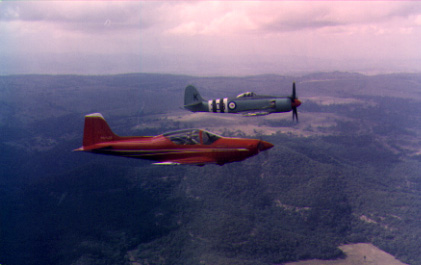
Guido Zuccoli in the Sea Fury flies wing on Dean Hall and Lynette
Zuccoli.
Now we all know how that kind of invitation goes: sure, "just let me know, and I'll be there!" The difference this time was that I was dealing with a quiet man, and when I looked inside Guido Zuccoli, I knew that he meant it. The airplane was finished a few months ago, being the first in Australia, the invitation was reconfirmed, and tentative plans were made.
Then came the gear-up incident three weeks before Mangalore. Guido called me and said that it was off; and 40 minutes later he called to say that if I were still a gambling man, I could make plans to come ahead because they thought that they could fix it in time. I had to commit to an airline ticket then or never, and elected to take the chance. Your photo in the December '92 FBL showed Wayne Milburn and Tony Chamberlin, the two who had done the actual building of the plane. Wayne made it his own personal project to get it ready, and he burned a lot of midnight oil to get it done.
This I found to be another example of the friendship and spirit of the Australians. These guys not only built the airplane, repaired it to perfection in record time, but were genuinely friendly and helpful to this American interloper who, after all their blood, sweat, and love's labor, came down there and was about to take their plane off to the big show and bask in the accolades. They deserve a medal for effort "above and beyond the call of duty."
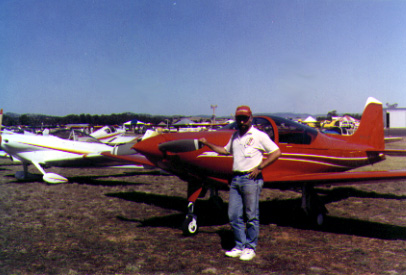
Wayne Milburn and the Falco.
And accolades there were. Everywhere we went the Falco was the star of the show. The airplane itself is perfection. It won the "Best Wood Airplane" award. Interesting, many Australians referred to it as being made of 'timber'. Being the so-called 'chief judge' at Oshkosh, I can say that it would have been in contention for the very highest awards at Oshkosh.
I can go further and say that the calibre of the homebuilts at Mangalore was across-the-board the equivalent of Oshkosh. Their workmanship in general is superb. The Australians were inclined to be self-effacing and to preface their remarks and questions about Mangalore by saying, "Of course, it isn't Oshkosh." But once you get past that point, there was no difference. The numbers and size were less, but the planes, the camaraderie, the flying, the workmanship, the spirit was the same. I thoroughly enjoyed Mangalore.
On the trip to Mangalore, Guido flew the Sea Fury, Wayne flew the Boomerang, and I flew the Falco. Guido is the quintessential pilot. He was a member of the Australian national aerobatic team. He moves with equal ease from a fighter plane to a Pitts to a Falco or a Cub. I saw him fly, for his first time, a 50-hp ultralight, all aluminum, semi-scale P-51. I saw him do beautiful vertical rolls in his Pitts, and a T-28. He did a great airshow in the Boomerang, and nobody has accused the Boomerang of being a great airplane.
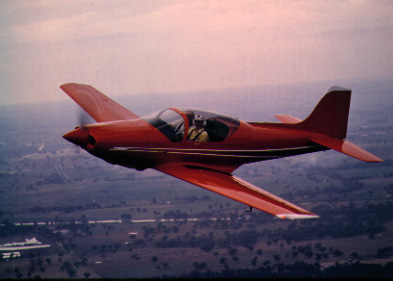
Dean Hall and Lynette Zuccoli in the Falco.
The Falco. First off, the Falco is the prettiest small airplane ever built. There are certain airplanes that are classics of design: B-17, DC-3, Super Connie, Staggerwing Beech, Gullwing Stinson, and so on. The Falco is one of these. Period.
You have already published some of the details of Falco VH-LZF (Lynette Zuccoli's Falco) and its performance as written by Tony Chamberlin. I would add that it is a delight to fly. I was particularly impressed with its stability in cross country. It flew like it was held by a thread suspended in outer space, perfectly balanced and responding to the slightest touch.
Tony has described his wooden dowel (taped under the right aileron trailing edge) trim tab, and it worked perfectly in maintaining the wings level. I would comment that having the entire 12-inch tab under the right aileron caused more drag on that side with a resultant need to keep a soft touch on the left rudder to counteract it and that moving half of the tab to the top of the left aileron, even though unsightly, would balance it out.
I was pleasantly surprised that there is no need to re-trim the aircraft for landing. The controls are light and well harmonized. They do load up a bit at speed and 'I like that'. Climb is great; forward visibility in the climb is not so great. At 5' 9", I found the Nustrini canopy a bit confining, and the thin seat cushions, modified to accommodate the canopy, uncomfortable after a couple of hours.
Limited aerobatics are outstanding. The roll is as good as it gets. The loop was great; being clean, speed on the backside has to be watched. The handling in the pattern in great. I would caution the new Falco pilot that because of its speed and complexity, things happen fast and that the average pilot, and that includes me, should get some dual and familiarization time before tackling it. In my case, I had the additional advantage of getting that dual time with Guido, who is a masterful pilot. The rudder nose gear linkages caused some different feel in the takeoff, and there was some rudder input during the gear down cycle which, until it was figured out, was slightly disconcerting.
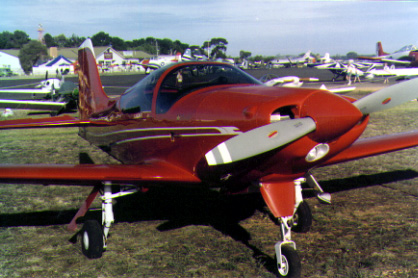
My observation was that the stall is not quite as predictable as I had expected with its stall strips. Let me digress to say that I disagree with the present instruction of pilots who experience the stall essentially only in the straight-ahead nibble in a trainer that is very spin resistant. Secondly, I contend that a lot of the new high-performance airplanes are achieving the last ounce of speed by ignoring basic aerodynamic safety lessons that were learned in the 30's. In addition, I think a lot of pilot reports of stall characteristics are biased by being limited to the most sanguine of stalls.
Now, back to the Falco: In the gliding, straight-ahead stall, it would usually give warning and break straight ahead. A non-soloed student could handle that. As I remember, it was not totally consistent. Everybody knows not to cross-control in a stall, but the classic low turn to final, especially with a slight tailwind in the base leg, can lead the pilot into trying to steer it around or 'cheat' with the rudder as I call it, and the result is catastrophic.
When I duplicated this in the Falco, at altitude, the result was a very sharp break without warning, and the roll went past the vertical before it could be stopped. This is not unique to the Falco by any means, but it is something to be aware of, and as a surprise to me the roll was quicker than in my Skybolt which being aerobatic might be expected to be worse. I suggest that the pilot of any airplane do stalls in all the combinations of turns with cross controls in order to really know what to expect.
I'm aware that we aren't supposed to cross-control, but having witnessed two fatal accidents in exactly that configuration, I know that it can happen; and I know from sad experience over nearly fifty years of flying that it is too easy to say that the last of our friends that got killed did something "stupid" that we would never do. But would we, when circumstances overload us? Good pilots have done it.
By the time we returned from Mangalore, I had 13.8 hours of Falco time in my log book, and as Guido observed, "That makes you the high-time Falco pilot in all of Australia." However, I don't attach too much to that; as they say, "In the land of the blind, the one-eyed man is king."
The bottom line is that I like the Falco very much, and needless to say, I wish I had one.
Overall, this was a classical once-in-a-lifetime trip. The flying was superb and gave me a chance to see almost 2,000 miles of Australian countryside that could not have been so well appreciated at airline altitude. We had the camaraderie of many airplane-type people, stopped in small towns, took part in municipal airshows, and generally appreciated the country and the people in ways that could not have been done otherwise.
Thanks to the Zuccolis, and to the Falco.
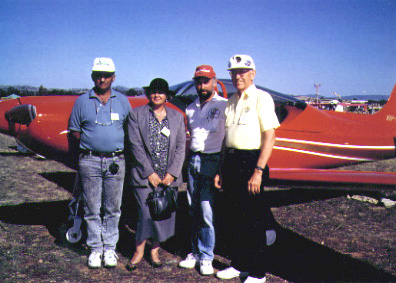
Guido and Lynette Zuccoli, Wayne Milburn and Dean Hall.
|
|